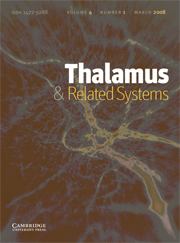Article contents
Nucleus-specific expression of NMDA receptor-associated postsynaptic density proteins in primate thalamus
Published online by Cambridge University Press: 12 April 2006
Abstract
Thalamic afferents and efferents primarily use the neurotransmitter glutamate, which acts through a variety of ionotropic (NMDA, AMPA, kainate) and metabotropic receptors. The NMDAR is composed of multiple subunits, NR1 and NR2A-D. The obligatory NRl subunit is expressed as one of eight isoforms, due to the alternative splicing of exons 5, 21, and 22. Each NRl splice variant is functionally distinct. For instance, alternative splicing of exons 21 and 22 renders two C-terminal variants, which differentially associate with NR2 subunits and intracellular molecules such the PSD-95 family of proteins. These PSD proteins play a pivotal role in NMDAR function by linking NMDARs to the cytoskeleton and downstream signal-transducing enzymes that can directly modulate NMDAR function and/or promote NMDAR-associated intracellular events.
Previous work reported that NRl is by far the most abundant NMDAR subunit expressed in the primate thalamus. In the current study, we extend these findings first by determining which NRl isoforms are predominantly expressed in the thalamus. Secondly, we characterize the expression of the NMDAR-associated PSD molecules, such as PSD-95, in the thalamus. Using in situ hybridization, we examined expression of the transcripts encoding NRl isoforms containing exons 5, 21, or 22, and transcripts encoding a set of the most well-characterized NMDAR-associated PSD proteins (NF-L, PSD93, PSD95, SAP102, and Yotiao). NRl exon 22-containing isoforms are the most abundant subunit transcripts, accounting for 40–50% of the NRl isoforms expressed in most thalamic nuclei. We also found that NF-L is by far the most abundant PSD protein expressed in the thalamus, followed by PSD-95, which is moderately and heterogeneously expressed. SAP102 and PSD-93 were expressed at moderate to low levels, with negligible amounts of Yotiao transcript expression. The PSD-95 family of molecules are critical for NMDAR function in the cell, and this study is the first to provide a detailed description of the expression of these molecules in primate thalamus. Our results demonstrate that NRl splice variants and associated PSD proteins are heterogeneously expressed across the thalamus, which is likely related to the intracellular events that occur in different thalamic nuclei.
Keywords
- Type
- Research Article
- Information
- Copyright
- 2002 Elsevier Science Ltd
- 3
- Cited by


